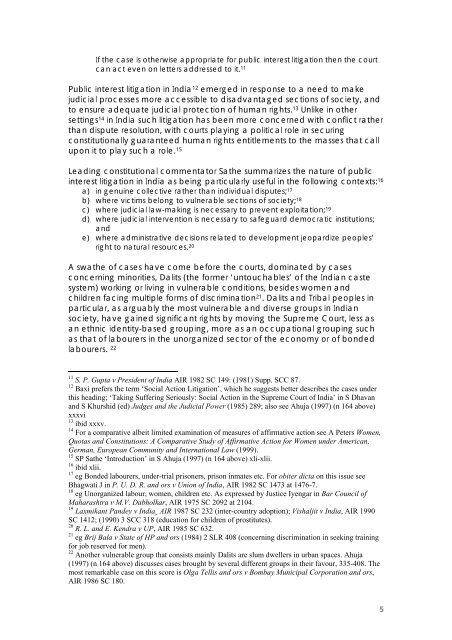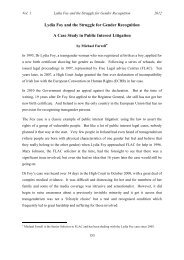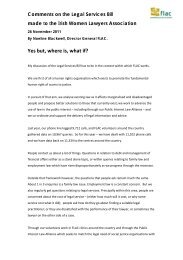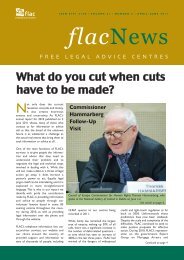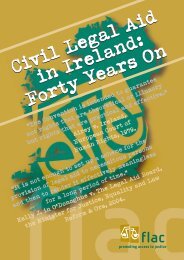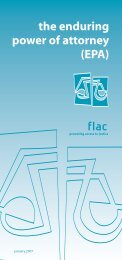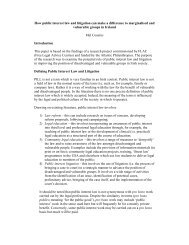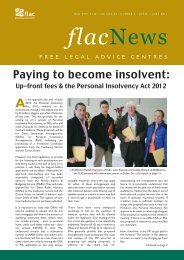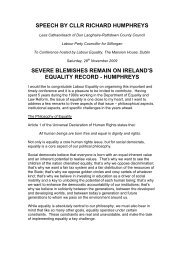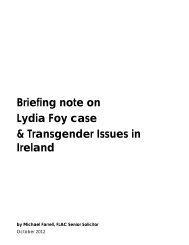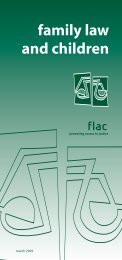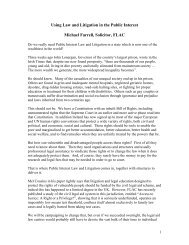Public Interest Litigation as a Tool for Vulnerable Groups: Lessons ...
Public Interest Litigation as a Tool for Vulnerable Groups: Lessons ...
Public Interest Litigation as a Tool for Vulnerable Groups: Lessons ...
Create successful ePaper yourself
Turn your PDF publications into a flip-book with our unique Google optimized e-Paper software.
If the c<strong>as</strong>e is otherwise appropriate <strong>for</strong> public interest litigation then the courtcan act even on letters addressed to it. 11<strong>Public</strong> interest litigation in India 12 emerged in response to a need to makejudicial processes more accessible to disadvantaged sections of society, andto ensure adequate judicial protection of human rights. 13 Unlike in othersettings 14 in India such litigation h<strong>as</strong> been more concerned with conflict ratherthan dispute resolution, with courts playing a political role in securingconstitutionally guaranteed human rights entitlements to the m<strong>as</strong>ses that callupon it to play such a role. 15Leading constitutional commentator Sathe summarizes the nature of publicinterest litigation in India <strong>as</strong> being particularly useful in the following contexts: 16a) in genuine collective rather than individual disputes; 17b) where victims belong to vulnerable sections of society; 18c) where judicial law-making is necessary to prevent exploitation; 19d) where judicial intervention is necessary to safeguard democratic institutions;ande) where administrative decisions related to development jeopardize peoples’right to natural resources. 20A swathe of c<strong>as</strong>es have come be<strong>for</strong>e the courts, dominated by c<strong>as</strong>esconcerning minorities, Dalits (the <strong>for</strong>mer ‘untouchables’ of the Indian c<strong>as</strong>tesystem) working or living in vulnerable conditions, besides women andchildren facing multiple <strong>for</strong>ms of discrimination 21 . Dalits and Tribal peoples inparticular, <strong>as</strong> arguably the most vulnerable and diverse groups in Indiansociety, have gained significant rights by moving the Supreme Court, less <strong>as</strong>an ethnic identity-b<strong>as</strong>ed grouping, more <strong>as</strong> an occupational grouping such<strong>as</strong> that of labourers in the unorganized sector of the economy or of bondedlabourers. 2211 S. P. Gupta v President of India AIR 1982 SC 149: (1981) Supp. SCC 87.12 Baxi prefers the term ‘Social Action <strong>Litigation</strong>’, which he suggests better describes the c<strong>as</strong>es underthis heading; ‘Taking Suffering Seriously: Social Action in the Supreme Court of India’ in S Dhavanand S Khurshid (ed) Judges and the Judicial Power (1985) 289; also see Ahuja (1997) (n 164 above)xxxvi13 ibid xxxv.14 For a comparative albeit limited examination of me<strong>as</strong>ures of affirmative action see A Peters Women,Quot<strong>as</strong> and Constitutions: A Comparative Study of Affirmative Action <strong>for</strong> Women under American,German, European Community and International Law (1999).15 SP Sathe ‘Introduction’ in S Ahuja (1997) (n 164 above) xli-xlii.16 ibid xlii.17 eg Bonded labourers, under-trial prisoners, prison inmates etc. For obiter dicta on this issue seeBhagwati J in P. U. D. R. and ors v Union of India, AIR 1982 SC 1473 at 1476-7.18 eg Unorganized labour, women, children etc. As expressed by Justice Iyengar in Bar Council ofMahar<strong>as</strong>htra v M.V. Dabholkar, AIR 1975 SC 2092 at 2104.19 Laxmikant Pandey v India¸ AIR 1987 SC 232 (inter-country adoption); Vishaljit v India, AIR 1990SC 1412; (1990) 3 SCC 318 (education <strong>for</strong> children of prostitutes).20 R. L. and E. Kendra v UP, AIR 1985 SC 632.21 eg Brij Bala v State of HP and ors (1984) 2 SLR 408 (concerning discrimination in seeking training<strong>for</strong> job reserved <strong>for</strong> men).22 Another vulnerable group that consists mainly Dalits are slum dwellers in urban spaces. Ahuja(1997) (n 164 above) discusses c<strong>as</strong>es brought by several different groups in their favour, 335-408. Themost remarkable c<strong>as</strong>e on this score is Olga Tellis and ors v Bombay Municipal Corporation and ors,AIR 1986 SC 180.5


